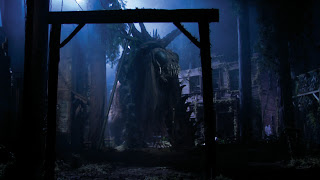
Get it? Like Night of the Living Dead? You know, that $50-budget film from the '60s that filmmakers have been ripping off ever since? I guess it doesn't matter. Gimmicky title or not, any horror fan worth their weight in cinematic excrement knows any movie about the walking dead who infect via bite/scratching and can only go down for good with a shot to the head has been directly inspired by that hemp-smoking Pennsylvania native in the safari vest.
It is the mid 1300s and the Black Plague is ravaging the land. Nearly 1/3rd of the world's population is in the process of dropping dead (thanks a lot, rats!), but that is not stopping one ragtag group of crusaders from escorting the Holy Grail (?) to a place unknown, but in actuality perhaps to hide it from that blonde Nazi who talks in her sleep from The Last Crusade. Along the way they encounter blood-spattered mindless humanoids who saunter toward them with nothing in their eyes, but their eyes on the men's delicious epidermis. Finding themselves surrounded at every side by a growing army of the zombie persuasion, the knights prepare to battle, and get gooey guts all over pretty much everything.

Perhaps inspired by the popularity of HBO's "Game of Thrones," a show that combines traditional fantasy/King Arthur-esque storytelling with mature themes, icky monsters, and all kinds of violence (though doesn't share nearly its budget of one episode), Knight of the Dead, if nothing else, at least takes itself seriously. Thematically similar to Christopher Smith's The Black Death (starring that headless "Game of Thrones" guy), the tone is bleak, the men seem haunted, the film stock is bleached, and things seem hopeless. (It IS the plague we're talking about here.) That's pretty much where the similarities end, as The Black Death was a great film made by a great filmmaker. While Knight of the Dead isn't terrible, there's nothing about it that injects the viewer with any sense of intrigue.
I have seen a lot of fellow reviewers tear down this film and I guess, while I can see why, I don't feel as obligated to do so myself. In the pantheon of zombie films, it's certainly not at the very bottom, but it is most certainly down there somewhere. I say without hesitation it's superior to the majority of the Resident Evil sequels and any remake of Romero's Night sans the Savini version. (And it's definitely better than the other Black Plague horror travesty Season of the Witch, but that's not really saying all that much, is it?)
Knight of the Dead tries to offer something new – zombies eating dudes during the Dark Ages – but the stark landscapes and the condemnations of witchcraft and the wailing, moaning soundtrack makes this all feel so damn familiar that the fact there are zombies included now doesn't really raise the stakes at all. This new trend of take-new-setting/add-zombies/shake-well sometimes results in some truly great films (see Exit Humanity), but sometimes it results in something like Knight of the Dead. What CGI that's utilized ranges from spotty to "Jesus, that's bad," but in a film where knights do back-flips and it's apparently possible to split zombies perfectly in half from head to hips, it's the most minor of qualms. Though inoffensive, competently assembled, and including zombies being eviscerated by battle axes, there's nothing particularly memorable about it.
Also, despite that cover, there is not ONE scene featuring a knight in a suit of armor battling an army of ghouls. I mean, come on...that scene writes itself.
Also, despite that cover, there is not ONE scene featuring a knight in a suit of armor battling an army of ghouls. I mean, come on...that scene writes itself.

Come the next day, when you're rinsing out your coffee mug in the break-room sink and someone asks if you saw any good movies recently, not only are you not going to name-drop Knight of the Dead, you're likely to have forgotten you even watched it.




































